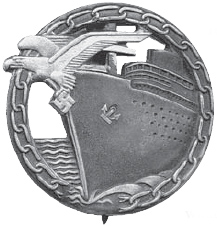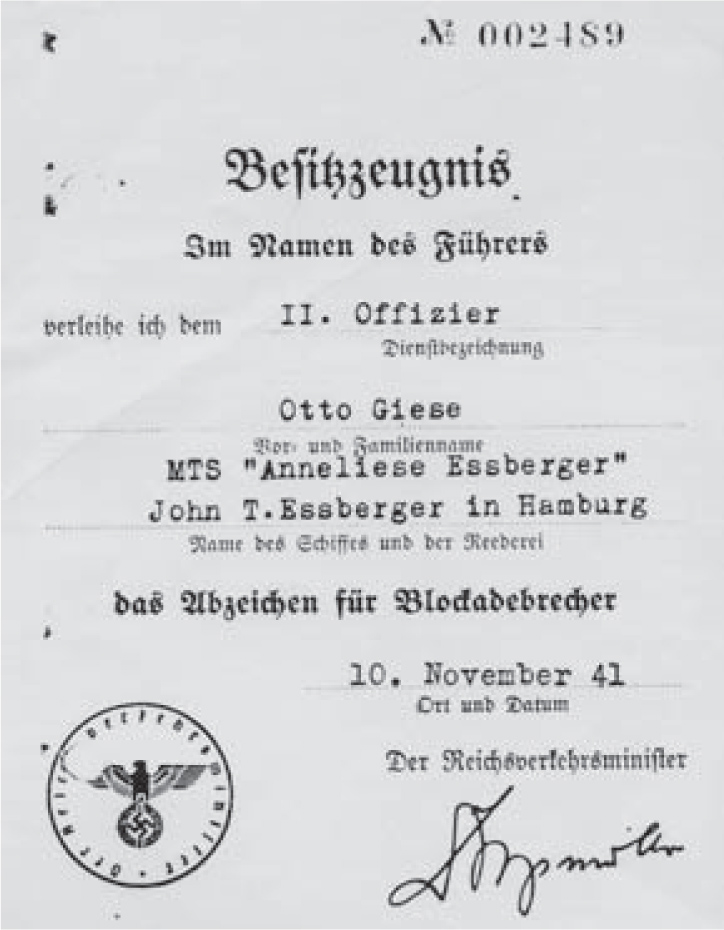
In common with other nations, the German Navy commandeered many merchant vessels for military use. These were classified into a whole range of supply ship classes, many of which retained their original merchant navy crews on temporary secondment to the Kriegsmarine for the duration of hostilities. A typical example was the Jan Wellem, the mothership of the German whaling fleet, which served with its original merchant navy crew in the invasion of Norway and was severely damaged at Narvik.
However, there were also a small number of purpose-built fleet auxiliaries of the Dithmarschen class, produced in 1936 and 1937. It had originally been intended that these ships could double as auxiliary cruisers; it was later decided that their role as supply ships was too valuable to divert them onto combat duties as auxiliary warships, but their original intended role was reflected in the manner in which their main armament was concealed behind collapsible panels.
As indicated by their official designation as Flottentross-schiffe, these vessels came under the control of Fleet command via the Chef des Tross-schiffverbandes headquartered in Wilhelmshaven, and not the Sicherungsverbände. These ships would typically carry fuel, ammunition, food, machine parts and even mail from home. The crews were Kriegsmarine personnel, but were recruited for the Navy from experienced merchant seamen who, already possessing all the seamanship skills required, simply needed to be put through an abbreviated military training programme.
A total of five new supply ships were built: Dithmarschen, Uckermark (originally Altmark), Nordmark (originally Westerwald), Ermland and Franken. Only Dithmarschen and Nordmark survived the war, the former serving with the US Navy until scrapped in 1960, and the latter with the Royal Navy until 1955.

The supply ship (Tross-schiff) Tannenfels, which resupplied several of the auxiliary cruisers on their many successful wartime raiding cruises. Note that – somewhat unusually for a supply ship – she is carrying a floatplane (silhouetted behind the funnel), but this was most likely a replacement she was transporting to one of the commerce raiders. (Deutsches U-Boot-Museum)
| Specifications for the class: | |||
| Length | 178m | Powerplant | 2 x Wagner turbines |
| Beam | 22m | Top speed | 21 knots |
| Displacement | 20,860 tons | Endurance | 12,500 nautical miles |
| Armament | 3x 15cm guns, 2x 3.7cm flak, 4x 2cm flak | Crew | 100-200 |
Dithmarschen began her career as a supply tanker for German warships involved in non–intervention patrols during the Spanish Civil War, on the conclusion of which she went into dry dock for repairs and refitting. She returned to active service in June 1940, providing refuelling for the battleships Scharnhorst and Gneisenau, the heavy cruiser Admiral Hipper and numerous destroyers during Operation ‘Juno’, an attempt to interdict supply movements for the British force fighting in Norway. In November 1940 she was scheduled to accompany the pocket battleship Admiral Scheer on operations but was forced to return to port due to engine problems.
Bad luck continued to dog the Dithmarschen, and in January 1941, when setting off on a further refuelling mission for Scharnhorst and Gneisenau, she ran aground. Out of action for some time during repairs, she returned to service in 1943, acting as a supply tanker for Kriegsmarine ships operating from Norwegian harbours. At the end of the war Dithmarschen passed to the US Navy, who renamed her Conecuh. She served for ten years, being retired to the reserves in 1956 and finally scrapped in 1960.

The Blockade-Breaker Badge, showing a merchant vessel, its prow adorned with the eagle-and-swastika, breaking through a chaOn the outbreak of war Westerwald win symbolizing the Allied blockade. (Author’s collection)
On the outbreak of war Altmark was operating in the South Atlantic, as the supply ship for the Admiral Graf Spee. After the scuttling of that raider Altmark successfully ran the Allied blockade into what were assumed to be relatively safe waters, still carrying a number of captured merchant seamen who had been transferred from the Graf Spee. However, radio traffic from the Altmark had been intercepted by the British, and she was located by the Royal Navy destroyer HMS Cossack off the coast of then-neutral Norway. On the appearance of Cossack on 16 February 1940 she ran for refuge in Norwegian territorial waters, but the destroyer followed her and boarded her; a number of allegedly unarmed German sailors were shot while the boarding party released the prisoners. It is believed that this event led Hitler to suspect Norwegian collusion with Britain and to hasten his plans for the invasion of Norway.
 |
RAUBTIER CLASS TORPEDO BOAT IN ACTION 12 FEBRUARY 1942 |
| Once the Low Countries and France had fallen in May–June 1940 and Germany took control of their ports on the coasts of the North Sea, English Channel and Atlantic, torpedo boats operated from the North Sea right down into the Bay of Biscay. They were often involved in fierce engagements with British warships; but the most significant single operation in which the torpedo boats took part was the famous ‘Channel Dash’, when the battlecruisers Scharnhorst and Gneisenau and the heavy cruiser Prinz Eugen broke out from Brest and, thanks to a brilliantly executed plan of continuous sea and air support, sailed safely up the Channel to return to dockyard facilities in German ports. The belated and unsuccessful attempts by British naval and air forces to stop them were costly for the RN Fleet Air Arm and the RAF. | |
| This plate shows a torpedo boat of the escort force under attack from Spitfire fighter aircraft. The boat is sporting an interesting ‘splinter’-style disruptive camouflage scheme in dark grey and medium blue-grey over her pre-war plain pale grey finish. During this operation the torpedo boat Jaguar suffered the highest casualties on the German side – just one man killed and one wounded. Fast and manoeuvrable even in heavy seas, this class of boat carried a 3.7cm flak gun and anything between two and 12 light 2cm flak guns. Their anti-aircraft armament was continuously upgraded throughout the war, and a torpedo boat at speed thus presented a target both difficult to hit and capable of putting up a robust defence. |


The award document for the Blockade-Breaker Badge awarded to Otto Giese. Note the interesting additional line below the ship name MTS Anneliese Essberger – ‘John T.Essberger in Hamburg’ – the shipping line to which the ship belonged. The date, 10 November 41, is a month before the US entry into the war. On reaching Germany, Giese transferred to the U-boat branch, and served at one point with the top ‘ace’ Wolfgang Lüth. (Otto Giese)
On her return to Germany the Altmark was renamed as the Uckermark, and subsequently served in the Pacific and Indian Oceans as supply ship for the auxiliary cruiser Thor. In November 1942, while moored in Yokahama in Japan, Uckermark was torn apart by a huge explosion believed to have been caused by sparks during cleaning work on her fuel tanks.
On the outbreak of war Westerwald was serving as supply tanker for the pocket battleship Deutschland; after returning to Germany in December 1939 she was renamed Nordmark. After taking part in the invasion of Norway, she was damaged in an air raid in July 1940 and spent two months undergoing repairs. Her next task was to serve as supply tanker for the Admiral Scheer, undergoing a long and successful cruise in which she covered more than 33,600 miles during over 250 days at sea. From March 1942 until the end of the war, Nordmark served as a supply tanker for German naval units in Norway.
After the cessation of hostilities she was taken into the Royal Navy, where she served as the Bulowayo. She was scrapped in 1955.
Launched in 1939, Ermland was commissioned into the Kriegsmarine in September 1940. She was despatched to act as a supply tanker for the battleships Scharnhorst and Gneisenau, but was recalled when those warships were unable to break out into the Atlantic. From January to March 1941 she served them during Operation ‘Berlin’, a raiding cruise against Allied merchant shipping. Shortly after the conclusion of this mission Ermland was ordered to sea again to support the damaged Bismarck as she struggled to reach the safety of occupied France, but the tanker was recalled when the news of Bismarck’s sinking was received. Her relatively short career ended in September 1942 when she ran onto a mine, and had to go into dry dock for repairs. Whilst in port in Nantes she was severely damaged during an air raid in September 1943, and rendered unserviceable. She was eventually sunk as a block-ship at Nantes in August 1944.
Franken was not completed until September 1943, and spent her war rather uneventfully in the Baltic on supply operations. She suffered a direct hit when bombed by Soviet aircraft on 8 April 1945, broke in half, and rapidly sank.